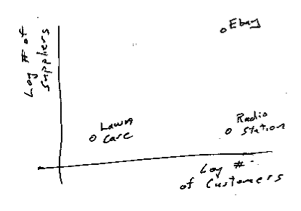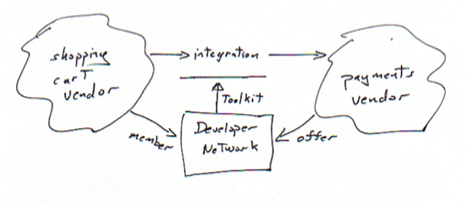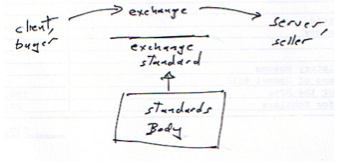I’ve spent a half day twice at LinuxWorld here in Boston.
There are some traits that partition the universe of exhibitors. Big firms, little firms, and “dot orgs.” Hardware, Software. Developer facing, enterprise facing. The Developer facing fall into two camps; hardware and software. There are folks in booths, folks in stations inside somebody else’s booth, and then guys wandering around on the floor.
Generally I find the big firm booths lacking in authenticity; over designed booth furniture; bevies of bitter beautiful booth barista; huge lcd screens owned by power point; presenters who’s talk is feed into their ear from a tape player. Sometimes a gimick; for example Sun and AMD have a lan party setup. Well, it’s not a party it’s a contest and it’s obnoxiously loud. All it’s neighbors are pissed.
Redemption for a big firm booth is possible. Some of the firms have let out a big chunk of their real estate to stations occupied by their “developer partners.” These are typically just like little the small firms; except they are sitting at a station that lacks the authentic signs of a real firm – i.e. somebody eating in the back of the booth, the luggage, or better yet a child. This lack of authenticity meant I didn’t actually realize they were there for a while.
In a strange demonstration of some kind of emerging hierarchy of nobility I spent a while talking to a guy in a station at a huge firm who runs the developer network for mediums sized firm and then later in the space of the medium size firm I spoke to guys at stations he had provided them.
There is a lot of stuff going on around ‘thin client.’
I think my favorite booth was LTSP.org’s. They guys seem to mostly work in schools. Their problem; a huge pipe of misc. computers – old, donated, random – that they can’t bring them selves to give away. So they have given life to the thin-client network computer fantasy. Except this time it works. You get the feeling that if it has a CPU, a screen, and a keyboard these guys can make something useful out it. Disk? no way! I’d never notice etherboot.org before. This is such a hack! They replace the ROM on the ethernet card so that you can bootstrap off it, and then off the net. The traffic at both these booths was huge.
I had fun talking to buys who’s companies sell thin client hardware. They all have really fun surprising customer stories. Like the schools making useful stuff out of old junk these guys are really making people’s lives better in little insurance offices, auto dealers, etc. etc.
Lots of people say document management in their booth signage. I don’t think two of them are doing the same thing! I had a lot of fun talking to a guy who’s document management system has mostly gotten used to capture faxes, and scans of paper documents in small to medium sized offices.
I’m mostly not that interested in the enterprise facing vendors; but there is an trend there. When I used to go to Mac World you would see trends. Sometimes they were huge – like one year there were a dozen disk drive expansion vendors. The next year there would be two. The following year there would be none, or one. The trend I think you can see here is tools from small vendors to help solve what could be called the migration problem (moving from Windows to Linux for example) or it could be called the heterogeneous systems problem. I like the second term better. I think we are moving into a much more complex and confusing IT world. Lots of junk of various kinds. A dozen databases where somebody obsessive might prefer one. A hundred systems all jockey for screen space in front of the person getting the work done. Of course if there was nothing but time then we could integrate those hundred systems into one rational unified UI; but who’s got time? It’s much more fun to solve problems and move on to the next problem. Getting a pretty unified UI or master database schema is navel gazing.
So we get the hacks to assure documents of a given account number to pop up in the web browser when ever the call handling software receives a call. We get hacks to keep N different employee account databases in synch. Why N? Mergers, politics, expedience. Surely your not going to tell one division that they can’t install a system that gets them a huge productivity improvement just because it happens to integrate poorly with the LDAP directory you the parent company’s obsessive compulsive IT group has wedded themselves to?
The outlook substitutes market is looking healthy. Someday that’s going to totally disrupt the outlook/exchange network hub. But it’s only motivation right now is cost. CIO’s do not care about cost. They care about risk. They care about game changing advantage. They care about keeping a lid on diversity, aka chaos. Offensively, they are typical monopolists. So these offerings remain poorly impedance matched to the customers that have huge outlook/exchange installations.
There are a lot of offerings in the network monitoring space. Like all of software these show little correlation between features and price.
When I browse at these open source shows I’m always struct by how rarely my “man that’s cool” reaction is. During the first years of the Mac it was a very very common experience. Rich geographic database apps on the mac in 1986, for example. Or the constraint based drawing programs. Or the way that you could drop an object into a pallet and the pallet would learn that subset of the attributes of the object which were relevant to the pallet and create a new cell in the pallet.
I expected I’d see cool innovations in the network monitoring booths. But mostly not. There were some clever tricks for packing more info in the trend graphs; but not really surprising. Nobody seems to be making any progress on the hard problem – managing the alert population given the human failings of the recipients of the alert stream.
I did like the system that observes the OS call patterns of your application and then generates alerts when new things happen.
Nobody seems to be doing anything that creates collaboratively authored rule sets.
I’m always amused by how some booths are vicious in their lead qualification. They have one or maybe two questions they ask and if you don’t happen to give the right answer they ignore you and go back to talking to themselves. They have got that evil beast serendipity in a cage.
 Zooming in on the landscape of the supply chain/graph we can make a very simple model of the firm. The firm has some skills which it plies by drawing inputs from suppliers and creating outputs for it’s customers. For example a lawn mowing business. On the supplier side a few employees, equipment suppliers, insurance, accountant, a bank, maybe a phone. On the customer side maybe a hundred customers. Not too much skill; mostly the skill of keep all these relationships functioning.
Zooming in on the landscape of the supply chain/graph we can make a very simple model of the firm. The firm has some skills which it plies by drawing inputs from suppliers and creating outputs for it’s customers. For example a lawn mowing business. On the supplier side a few employees, equipment suppliers, insurance, accountant, a bank, maybe a phone. On the customer side maybe a hundred customers. Not too much skill; mostly the skill of keep all these relationships functioning. Then there are firms with huge numbers of suppliers and customers. A fast food restaurant chain for example has lots and lots of employees, real estate deals, local legal & political connections, on the supply side along with numerous customers on the other. Or consider eBay with it’s huge pool of sellers who supply it with goods and it’s huge pool of buyers who receive those goods. Or consider Google with its huge pool of content providers v.s. its pool of eyeballs searching for goods.
Then there are firms with huge numbers of suppliers and customers. A fast food restaurant chain for example has lots and lots of employees, real estate deals, local legal & political connections, on the supply side along with numerous customers on the other. Or consider eBay with it’s huge pool of sellers who supply it with goods and it’s huge pool of buyers who receive those goods. Or consider Google with its huge pool of content providers v.s. its pool of eyeballs searching for goods. This illustration shows this business scheme. The payment companies, people like Paypal and Authorize Net, want a lot of shops to integrate with them. So they offer a developer network to attract the vendors who serve shop owners. Those vendors, the guys that make shopping cart solutions, join the developer network and use it’s services to integrate their offerings with those of the payment company. The more successful the developer network becomes the more this drawing begins to look just like the drawing that describes an exchange standard.
This illustration shows this business scheme. The payment companies, people like Paypal and Authorize Net, want a lot of shops to integrate with them. So they offer a developer network to attract the vendors who serve shop owners. Those vendors, the guys that make shopping cart solutions, join the developer network and use it’s services to integrate their offerings with those of the payment company. The more successful the developer network becomes the more this drawing begins to look just like the drawing that describes an exchange standard. Which is probably because from an appropriate distance they are the same drawing. The work that a developer network does as it campaigns to attract developer members, get them to sign up, integrate, and succeed is identical to the work a standards body ought to do as it campaigns to drive adoption of it’s offering. Both the standards body and the developer network are attempting to define a platform (represented in these drawings by the line below the exchange or integration).
Which is probably because from an appropriate distance they are the same drawing. The work that a developer network does as it campaigns to attract developer members, get them to sign up, integrate, and succeed is identical to the work a standards body ought to do as it campaigns to drive adoption of it’s offering. Both the standards body and the developer network are attempting to define a platform (represented in these drawings by the line below the exchange or integration).